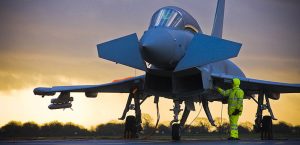2016-11-14 By Robbin Laird
During a June 2016 visit to RAF Lossiemouth, I had a chance to discuss the GSS or Ground Support System approach for the Typhoon with an RAF officer involved with GSS.
This digital system is a key part of both maintaining the Typhoon and enhancing its performance going forward.
According to a publication by Eurofighter Typhoon, the system is described as follows:
“The implementation into the aircraft of advanced Built-In Test and diagnostic features has substantially reduced the number of Ground Support Equipment (GSE) compared to previous aircraft.
The remaining suite of state-of-the-art GSE was developed according to the same stringent standards as the aircraft, thus ensuring performance and reliability…..
The Ground Support System (GSS) gives all operators a leading edge mission and engineering data management.
This provides rapid seamless bi-directional data flow from the operational and maintenance centres to the aircraft and back. The GSS is linked to the National Support Centre and Industry, thus facilitating continuous on-line data and intelligence transfer.”
The RAF added this insight with regard to GSS:
“Information Communication Technology (ICT) Technicians play a pivotal role supporting, operating, and maintaining vital ICT subsystems essential to the support of Typhoon.
This is achieved by empowering Mechanical, Avionic and Weapons trades with the ICT capability to diagnose the critical engineering data produced by the aircrafts advanced computer systems.
Additional ICT expertise is also utilised by supporting aircrew and operations staff through the management of Mission Support Systems that are vital to the operational functionality of the aircraft.
In summary, we deploy and provide 24/7 support to all the stations day to day operations worldwide.”
The onboard computers on the Typhoon provide a steady stream of data into the brick carried within the aircraft.
That brick is removed after flight and the data downloaded to the ground IT system for diagnosis.

The data becomes part of the operational data base for the aircraft, and provides regular inputs to the ongoing assessment of the parts and components onboard the aircraft.
The data is used to provide the information necessary for servicing the aircraft and readying it for the next flight.
The data is also part of the lessons learned mission debrief performed by returning pilots from a mission.
It is a deployable system and part of the capability of Typhoon to deploy to areas of interest like the Baltics or the Middle East.
The GSS is a fundamental element in making the Typhoon an expeditionary aircraft.
The GSS officer highlighted that improvements were under way in ways to manage the data and display the results.
“We are getting better displays to show the findings which will, in turn, enhance our ability to service the aircraft.”
And serviceability is crucial to generate increases in the sortie generation of the aircraft as well.
The officer highlighted that the Typhoon experience is a key input to the RAF learning how manage data-generated by aircraft to be able to make steps forward into the age of ‘big data’ management.
These challenges will only increase as the P-8 and the F-35 come to the RAF, but the Typhoon experience is an important part of the RAF learning curve.

